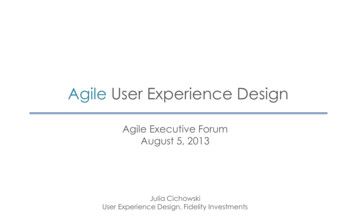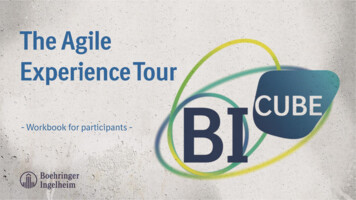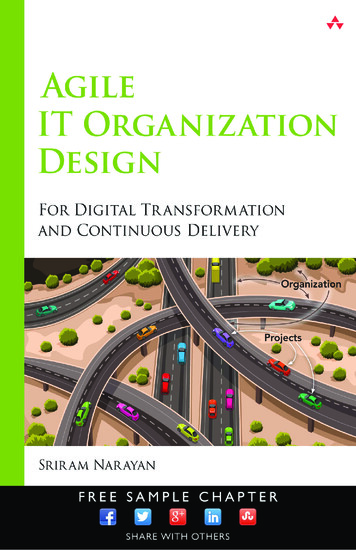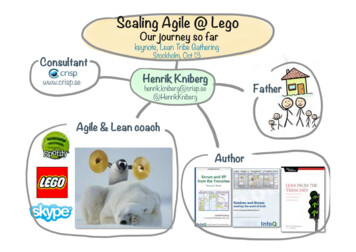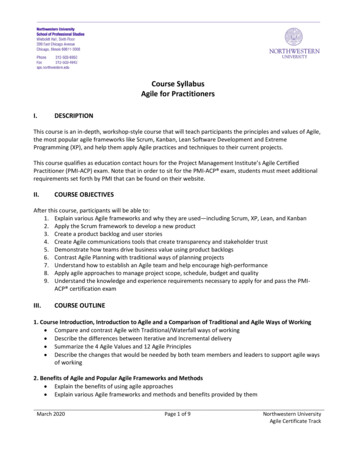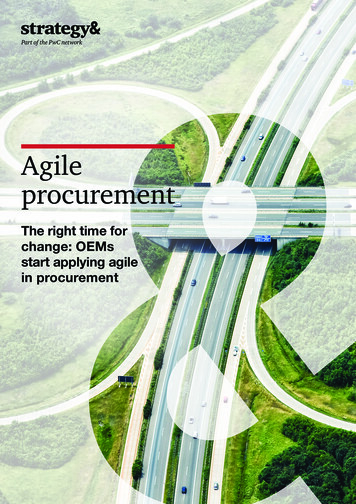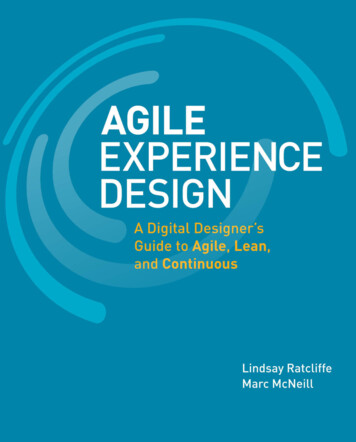
Transcription
AgileExperienceDesignA Digital Designer’sGuide to Agile, Lean,and ContinuousLindsay RatcliffeMarc McNeill
Agile Experience DesignA Digital Designer’s Guide to Agile, Lean, and ContinuousLindsay Ratcliffe and Marc McNeillNew Riders1249 Eighth StreetBerkeley, CA 94710510.524.2178510.524.2221 faxFind us on the Web at: www.newriders.comTo report errors, please send a note to: errata@peachpit.comNew Riders is an imprint of Peachpit, a division of Pearson Education.Copyright 2012 by Lindsay Ratcliffe and Marc McNeillAcquisitions Editor: Michael NolanProject Editor: Rebecca GulickDevelopment Editor: Margaret S. AndersonCopy Editor: Gretchen DykstraProduction Coordinator: Myrna VladicInterior Designer and Compositor: Danielle FosterCover Designer: Aren Howell StraigerCover Production: Jaime BrennerProofreader: Patricia PaneIndexer: Valerie Haynes PerryNotice Of RightsAll rights reserved. No part of this book may be reproduced or transmitted in any formby any means, electronic, mechanical, photocopying, recording, or otherwise, withoutthe prior written permission of the publisher. For information on getting permission forreprints and excerpts, contact permissions@peachpit.com.Notice Of LiabilityThe information in this book is distributed on an “As Is” basis, without warranty. Whileevery precaution has been taken in the preparation of the book, neither the authorsnor Peachpit shall have any liability to any person or entity with respect to any loss ordamage caused or alleged to be caused directly or indirectly by the instructions contained in this book or by the computer software and hardware products described in it.TrademarksMany of the designations used by manufacturers and sellers to distinguish their products are claimed as trademarks. Where those designations appear in this book, andPeachpit was aware of a trademark claim, the designations appear as requested bythe owner of the trademark. All other product names and services identified throughout this book are used in editorial fashion only and for the benefit of such companieswith no intention of infringement of the trademark. No such use, or the use of anytrade name, is intended to convey endorsement or other affiliation with this book.ISBN-13: nted and bound in the United States of America
AcknowledgEmentsWe are extremely grateful to everyone who has contributed to this book. Inparticular, we would like to thank the people who have created and contributedoriginal content in the form of both words and pictures. We are also grateful toeveryone who has kindly given us permission to include their thoughts, work,products, or mug shots in this book, and also to those who have given us feedbackthroughout the process. A big thanks to the team at Peachpit who have supportedus throughout this intense process and helped make this book what it is!Lindsay would like to give special thanks to my hubby, Guy Ratcliffe,without whom nothing would be possible. Your love, support, and constantencouragement have made my dreams come true. To my ‘little man’ who meltsmy heart even on stressy days. To my Dad, who kept the faith and alwaysbelieved in me. The thought of your smile still warms my heart, and I’ll miss youalways. To my Mum whose strength, perseverance, and determination continueto inspire me. To my brother whose unfaltering pursuit of the good life leavesme in awe. To Marc McNeill, thanks for your inexhaustible energy and passionabout all things XD. Thanks for sharing this journey—we make a great team! ToHubertus B and StakenKidney, you are my mentors and muses eternal. To thePufaSistas, the other half of BitchnCharmer, I am eternally grateful for what was,what is, and what always will be. To Andrew, Sarah & Shane, you were there,where it all began, and continue to influence and inspire me. To Claire and myother ‘Witches of EastTwick(enham),’ you are all amazing and your support andfriendship are invaluable. A big shout out to all my good friends and colleaguesat ThoughtWorks who have inspired my fresh perspective on design, customerexperience, and technology, and supported both of us through this process.Marc gives a big thank you to Graham Donaghue for giving me the nudge to writethis book and to Luke Barrett for his inspiration and support. Thanks to all theThoughtWorkers, both past and present, who have patiently listened to me rantabout the real customer whilst I’ve waved my hands in front of the whiteboard.They’ve taken me on a journey of agile discovery, from thinking a class wassomething I went to school in, to having a humble appreciation for the noble artof software delivery. Of this merry bunch, thanks in particular to Alex McNeill,Dan North, Luca Grulla, JM Domaingue, Prashant Gandhi, Jeff Patton, and myfellow experience designers Eewei Chen, Darius Kumar, and Diana Adorno.Thanks to my co-author Lindsay, who agreed to come on this journey and tookit to the next level. And finally thanks to my wife, Lindsey, for the patience andunderstanding she’s given me as I’ve written.
In a worldenriched byabundancebut disruptedby theautomationandoutsourcingof whitecollar work,everyone,regardlessof profession,must cultivatean artisticsensibility today wemust all bedesigners.—Daniel Pink,A Whole New MindForewordAs it enters its second decade, the agile movement must continue to innovateand adapt to remain relevant. This book by Lindsay Ratcliffe and Marc McNeillcontinues a string of agile innovations and adaptations. It brings design backinto the software delivery equation. “But, but,” agilists might say, “we alwaysdo design.” But Ratcliffe and McNeill are not talking about module designor database design; they’re talking about product design, graphic design,experience design, and more. This level of design is one of those things that is“hard to define, but I’ll know it when I see it.” As the authors say, great designmarries a desirable product with an engaging experience, a combination foundin Apple’s iPhone and iPad, for example.The early agile movement was a reaction to the problems of waterfalldevelopment: splintering of roles, piles of documentation, and little collaboration.The remedies to the problems of waterfall included working in short iterations,reducing the proliferation of roles, slashing documentation, and fostering intensecollaboration. But, as it turns out, specialisation wasn’t the primary problem—collaboration was. As the agile movement has matured, we’ve added backspecialists as we’ve learned to integrate them into agile teams. That’s not to saythat having a more general set of skills isn’t very valuable, but in our complexworld there is still a need for expertise in certain areas.Another trend over the last decade has been to show how, in a variety of ways,the statement “agile won’t work for or with xyz” is false. Issues with largeprojects, distributed teams, database-centric products, legacy systems integration,non-greenfield development, specific technologies, and practices like user-interfaceand experience design have all been addressed by innovative agilists.Agile Experience Design: A Digital Designer’s Guide to Agile, Lean, and Continuouscontinues these trends by showing how experience design can be integratedinto agile products and how designers can be integrated into agile teams. Thebook delves into the many facets of design and how they can be incorporated tocreate an engaging experience for customers, and brings the critical issues ofdesign to designers and non-designers alike.Because, to repeat Daniel Pink, “today we must all be designers.”Jim HighsmithExecutive Consultant and author of the Agile Manifesto andAgile Project Management
PrefaceWhy read this book?This is the book we wish we’d had when we were first introduced to agilemethods. We want to show how design and agile are a natural fit together.How bringing together the people who build the products you design with thepeople who use the products you design will lead to better decisions and bettercustomer experiences. We want to make the experience of designing in an agileenvironment easier and more compelling. How you no longer need to do all yourwork ‘up front’ but work collaboratively and continuously, adapting to the changesthat are inevitable in the lifetime of a digital project.Who are you?This book is primarily aimed at experience designers (and related roles) whowork in an agile environment. It’s for people who are striving to create excellent,customer-centric products and services yet want to be more adaptive, efficient,and collaborative. It doesn’t matter if, like us, you have a long tenure as anexperience designer and are just coming to agile for the first time, or if you’re juststarting out as an experience designer.You’ll also benefit from reading this book if you’re a project manager, productowner, developer, tester, or business analyst working with experience designers inan agile environment. You’ll understand more about what experience designersdo, what they need, how to get the most out of them, where they fit into theprocess, and how to collaborate with them.What to expectWe’re not reinventing the wheel. You won’t necessarily find a whole bunch ofnew techniques. Instead, we’ve taken some best practises and used themto develop a framework and suggested approach for experience design in anagile context.There are already plenty of books on agile methods—this isn’t another one ofthose. Instead, we’ll give a general overview of agile and then get specific on howto do experience design activities on an agile project. We’ll look at the project lifecycle and beyond, showing you how to apply experience design to an agile project.
PrefaceviWe’ll look at experience design as an essential component of a successful, agile,cross-functional project team where customer experience is critical to project orbusiness success. We’ll explain why roles are much less important than havingthe right skills on the project and explore how the different functional roles on ateam can collaborate to create and deliver the project vision.How to use this bookTipThroughout the bookyou will also seethe lightbulb icon toindicate a tip.Part One introduces agile—even if you think you know all there is to know aboutagile, it’s still worth reading through to understand how and where experiencedesign fits in.Part Two is where we’ll look at the project process and explore experience designtechniques and activities in the context of the agile framework to help you delivergreat experiences.ToolboxWhen we refer to amethod, technique, oractivity in the mainpart of the book thatis described in theToolbox, you will seethe tools icon.At the end of the book you’ll find the Toolbox. Use this as a quick-reference guideto the tools and techniques and how you can adopt them in an agile environment.We hope to add to the toolbox over time on www.agileexperiencedesignbook.com.Let us know your favourite, tried and tested tools and we’ll endeavour to sharethose too.It’s a shared understandingThings change. That’s a key message in this book. There are a variety ofways that we can keep each other informed of changes to the thinkingabout agile and experience design. We’ll publish and post updates atwww.agileexperiencedesignbook.com as and when they occur, but we’dlove to hear your stories and thoughts, too.
ContentsPart OneChapter 1Looking at agile and why designers should careRedesigning Design3Creative heroes and IT villains . . . . . . . . . . . . . . . . . . . . . . . . . 4Don’t shoot the messenger . . . . . . . . . . . . . . . . . . . . . . . . . . . 5Design in a vacuum . . . . . . . . . . . . . . . . . . . . . . . . . . . . . . . . . 6Life and time has moved on . . . . . . . . . . . . . . . . . . . . . . . . . . 7A manifesto for agile experience design . . . . . . . . . . . . . . . . . . 8Make it collaborative, iterative, and intense . . . . . . . . . . . . . . 10Make the vision real . . . . . . . . . . . . . . . . . . . . . . . . . . . . . . . 11Continuously develop the detail . . . . . . . . . . . . . . . . . . . . . . . 12Make the design responsive . . . . . . . . . . . . . . . . . . . . . . . . . 13What are we waiting for? . . . . . . . . . . . . . . . . . . . . . . . . . . . . 14Chapter 2The Waterfall Has Dried Up15Current state . . . . . . . . . . . . . . . . . . . . . . . . . . . . . . . . . . . . . 16Agile deconstructed . . . . . . . . . . . . . . . . . . . . . . . . . . . . . . . . 23Agile experience design . . . . . . . . . . . . . . . . . . . . . . . . . . . . . 34Redefining done . . . . . . . . . . . . . . . . . . . . . . . . . . . . . . . . . . 37In summary . . . . . . . . . . . . . . . . . . . . . . . . . . . . . . . . . . . . . 40Coming next . . . . . . . . . . . . . . . . . . . . . . . . . . . . . . . . . . . . . 40Chapter 3I’m a designer, why should I care?41Is agile anti-design? . . . . . . . . . . . . . . . . . . . . . . . . . . . . . . . 42A big design challenge . . . . . . . . . . . . . . . . . . . . . . . . . . . . . 45Where design fits . . . . . . . . . . . . . . . . . . . . . . . . . . . . . . . . . 48Who are designers? . . . . . . . . . . . . . . . . . . . . . . . . . . . . . . . . 56In summary . . . . . . . . . . . . . . . . . . . . . . . . . . . . . . . . . . . . . . 60Coming next . . . . . . . . . . . . . . . . . . . . . . . . . . . . . . . . . . . . . 60Chapter 4Setting the Scene61An agile experience design project . . . . . . . . . . . . . . . . . . . . . 62Agile team structure and the role of the designer . . . . . . . . . . 68The agile project environment . . . . . . . . . . . . . . . . . . . . . . . . 77Agile project communication . . . . . . . . . . . . . . . . . . . . . . . . . 81Agile project management . . . . . . . . . . . . . . . . . . . . . . . . . . . 84
ContentsviiiIn summary . . . . . . . . . . . . . . . . . . . . . . . . . . . . . . . . . . . . . . 90Coming next . . . . . . . . . . . . . . . . . . . . . . . . . . . . . . . . . . . . . 90Part Two How to design compelling experiencesand deliver them—quicklyChapter 5Get ready to go93Identifying the problem—and the solution . . . . . . . . . . . . . . . 94How do we do it? . . . . . . . . . . . . . . . . . . . . . . . . . . . . . . . . . . 95The role of models in the process . . . . . . . . . . . . . . . . . . . . . 99Who do we need? . . . . . . . . . . . . . . . . . . . . . . . . . . . . . . . . 102How are we going to structure our time? . . . . . . . . . . . . . . . 108We’re together, what now? . . . . . . . . . . . . . . . . . . . . . . . . . . 113In summary . . . . . . . . . . . . . . . . . . . . . . . . . . . . . . . . . . . . . 114Coming next . . . . . . . . . . . . . . . . . . . . . . . . . . . . . . . . . . . . 114Chapter 6Agile Discovery115Getting started . . . . . . . . . . . . . . . . . . . . . . . . . . . . . . . . . . 116Three i’s of collaborative discovery . . . . . . . . . . . . . . . . . . . . 118Business Intentions . . . . . . . . . . . . . . . . . . . . . . . . . . . . . . . 120Customer insights . . . . . . . . . . . . . . . . . . . . . . . . . . . . . . . . 124Implementation . . . . . . . . . . . . . . . . . . . . . . . . . . . . . . . . . . 136Bringing it all together . . . . . . . . . . . . . . . . . . . . . . . . . . . . . 140In summary . . . . . . . . . . . . . . . . . . . . . . . . . . . . . . . . . . . . . 142Coming next . . . . . . . . . . . . . . . . . . . . . . . . . . . . . . . . . . . . 142Chapter 7Envisioning Success143Creating creative . . . . . . . . . . . . . . . . . . . . . . . . . . . . . . . . . 145Make it happen . . . . . . . . . . . . . . . . . . . . . . . . . . . . . . . . . . 148Idea generation . . . . . . . . . . . . . . . . . . . . . . . . . . . . . . . . . . 154Refine . . . . . . . . . . . . . . . . . . . . . . . . . . . . . . . . . . . . . . . . . 158Explore . . . . . . . . . . . . . . . . . . . . . . . . . . . . . . . . . . . . . . . . 159Validate . . . . . . . . . . . . . . . . . . . . . . . . . . . . . . . . . . . . . . . . 164
ixPivot . . . . . . . . . . . . . . . . . . . . . . . . . . . . . . . . . . . . . . . . . . 166In summary . . . . . . . . . . . . . . . . . . . . . . . . . . . . . . . . . . . . . 168Coming next . . . . . . . . . . . . . . . . . . . . . . . . . . . . . . . . . . . . 168Chapter 8Elaboration: Ready, steady, build169The minimum viable product . . . . . . . . . . . . . . . . . . . . . . . . 170User stories . . . . . . . . . . . . . . . . . . . . . . . . . . . . . . . . . . . . 172Goals and journeys . . . . . . . . . . . . . . . . . . . . . . . . . . . . . . . 179Estimation . . . . . . . . . . . . . . . . . . . . . . . . . . . . . . . . . . . . . . 192In summary . . . . . . . . . . . . . . . . . . . . . . . . . . . . . . . . . . . . . 196Coming next . . . . . . . . . . . . . . . . . . . . . . . . . . . . . . . . . . . . 196Chapter 9Into Development197Iterations: The heartbeat of delivery . . . . . . . . . . . . . . . . . . . 198Working as a team . . . . . . . . . . . . . . . . . . . . . . . . . . . . . . . .207Design documentation . . . . . . . . . . . . . . . . . . . . . . . . . . . . . 211Working with the product owner . . . . . . . . . . . . . . . . . . . . . . 216Working in iterations . . . . . . . . . . . . . . . . . . . . . . . . . . . . . . 217In summary . . . . . . . . . . . . . . . . . . . . . . . . . . . . . . . . . . . . . 230Coming next . . . . . . . . . . . . . . . . . . . . . . . . . . . . . . . . . . . . 230Chapter 10Beyond Agile to Continuous231What does launch look like? . . . . . . . . . . . . . . . . . . . . . . . . 233Beyond releases to continuous improvement . . . . . . . . . . . . 239Listen and measure . . . . . . . . . . . . . . . . . . . . . . . . . . . . . . . 245Do the numbers add up? . . . . . . . . . . . . . . . . . . . . . . . . . . . 262In summary . . . . . . . . . . . . . . . . . . . . . . . . . . . . . . . . . . . . 268Coming next . . . . . . . . . . . . . . . . . . . . . . . . . . . . . . . . . . . . 268Part ThreeThe ToolboxAffinity mapping . . . . . . . . . . . . . . . . . . . . . . . . . . . . . . . . . 271Analytics . . . . . . . . . . . . . . . . . . . . . . . . . . . . . . . . . . . . . . . 272As-is experience design review . . . . . . . . . . . . . . . . . . . . . . . 273Contents
ContentsxAs-is/to-be process mapping . . . . . . . . . . . . . . . . . . . . . . . . 274Camera as documentation . . . . . . . . . . . . . . . . . . . . . . . . . . 275Collaborative design . . . . . . . . . . . . . . . . . . . . . . . . . . . . . . 276Competitor review . . . . . . . . . . . . . . . . . . . . . . . . . . . . . . . . 277Context scenarios . . . . . . . . . . . . . . . . . . . . . . . . . . . . . . . . 278Contextual inquiry . . . . . . . . . . . . . . . . . . . . . . . . . . . . . . . . 279Customer experience/journey map . . . . . . . . . . . . . . . . . . . . 280Customer testing . . . . . . . . . . . . . . . . . . . . . . . . . . . . . . . . . 281Design review meeting . . . . . . . . . . . . . . . . . . . . . . . . . . . . . 282Elevator pitch . . . . . . . . . . . . . . . . . . . . . . . . . . . . . . . . . . . 283Ethnographic research . . . . . . . . . . . . . . . . . . . . . . . . . . . . 284Hot air balloon . . . . . . . . . . . . . . . . . . . . . . . . . . . . . . . . . . . 285Idea generation . . . . . . . . . . . . . . . . . . . . . . . . . . . . . . . . . . 286Information design . . . . . . . . . . . . . . . . . . . . . . . . . . . . . . . . 287Insights . . . . . . . . . . . . . . . . . . . . . . . . . . . . . . . . . . . . . . . . 288Look inside . . . . . . . . . . . . . . . . . . . . . . . . . . . . . . . . . . . . . 289Me and my shadow . . . . . . . . . . . . . . . . . . . . . . . . . . . . . . . 290Personas . . . . . . . . . . . . . . . . . . . . . . . . . . . . . . . . . . . . . . 291Product box . . . . . . . . . . . . . . . . . . . . . . . . . . . . . . . . . . . . 292Prototyping . . . . . . . . . . . . . . . . . . . . . . . . . . . . . . . . . . . . . 293Retrospective . . . . . . . . . . . . . . . . . . . . . . . . . . . . . . . . . . . 294Showcase . . . . . . . . . . . . . . . . . . . . . . . . . . . . . . . . . . . . . 295Stand-up . . . . . . . . . . . . . . . . . . . . . . . . . . . . . . . . . . . . . . 296Storyboarding . . . . . . . . . . . . . . . . . . . . . . . . . . . . . . . . . . . 297Story map . . . . . . . . . . . . . . . . . . . . . . . . . . . . . . . . . . . . . 298Task analysis . . . . . . . . . . . . . . . . . . . . . . . . . . . . . . . . . . . . 299Trade-off sliders . . . . . . . . . . . . . . . . . . . . . . . . . . . . . . . . . 300Index 301
SettingtheScene4“Coming together is a beginning.Keeping together is progress.Working together is success.” —Henry FordLet’s begin our journey into agile by understandingwhat makes agile different from other workingmethods and how all of this affects designers.
Looking atagile and whydesignersshould care62Success. Now there’s an interesting word. By definition, success means theaccomplishment of desired aims or goals. Achieving success is the holy grail ofany business or project. The pursuit of success is the reason businesses investtime and money; it’s the reason we take risks. This book is about design and wewant to look not only at what makes design successful, but also how the involvement of designers on an agile project contributes to the overall project, and ultimately business success.In this chapter, we’ll take an initial look at agile project management, communication styles, rituals, processes, and environments and then talk about ways toimprove the chances of both design and project success by integrating designand designers into the agile project framework.An agile experiencedesign projectTo get an idea of experience design on an agile project, let’s think about what’selaboratneeded to get us from the start to the finish. Creating a mental model for theseactivities makes them easier to understand and apply, so we’ve grouped theminto the following five stages (4.1).e olve discev oner envisiovdevelop 4.1Iterative activitiesgrouped togetherwith the agile projectframework.Project activities notdefinitive gatesThere are no hard and fast rules about where you should start or when you needto move on to the next set of activities. In fact, you might repeat some activitiesin each phase, iterating, testing, and building on previous learnings. Rather thanbeing prescriptive about how long and when, we recommend a more lean andagile approach. Just do what you need to do and then move on. If you find you’remissing information at any given point, you can simply iterate through the activities again and build on your initial findings.
63SettingtheSceneDiscover—ask whyWe look to gather customer, business, and technical insights that will provide uswith the customer and business goals and identify opportunities for inspiration,improvement, and innovation. Often, you’ll find stakeholders entering the processassuming they already know the answers to the why and what questions. Great ifthey do! Your objective is to get their thinking out on the table to be understoodand agreed to by all the stakeholders. Equally, there may be some scenarioswhere nobody has really stopped to ask why. The idea sounds good on paper, butwhy should anybody care? Who are the customers and why might they use it?What do they really want and need? If we can’t answer those questions, we’renot ready to think about the how. There’s no point in pulling together a plan if thefundamental proposition isn’t going to fly.Gather customer, business, and technical insights that provide insightinto customer and business goals and identify opportunities for inspiration,improvement, and innovation.Envision—ask whatNow that we’ve identified the customer and business goals, we can ask what weneed to do to meet them. We don’t want just one solution at the start. We’relooking for a design vision, a direction for the product, with the full knowledgethat this may change as the product evolves.We place the customer at the heart of our design thinking to producea multitude of ideas to create different opportunities.We rapidly test these ideas with the people whose lives will be touched by theproduct we build for them. Those that are promising we’ll elaborate on. Thosethat are duds we’ll kill early and cheaply.
Looking atagile and whydesignersshould care64The key to our approach is not to spend months thinking. The market is movingon. The decision on how far to go will depend on the context and the maturity ofthe business. If you’re a start-up, you don’t have the luxury of testing ideas ina closed environment. You want to get stuff to market as soon as possible andadapt as you go. If you have an established product in an established marketplace, you may wish to build a prototype to test your ideas before committingto costly development.Elaborate—ask howWith a design vision in mind we now look to do just enough to start development.We elaborate on the vision and plan what we’ll need to do to get a product intoproduction as quickly as possible. We’ll agree on a first cut of the project scope:what the desired customer journeys are, sketches to illustrate screens, and userstories that are estimated and prioritised.Develop—let’s do itAgile software development is a social activity. No longer does the designerthrow artefacts over the fence in the hope that they may be delivered; in theagile process the designer is a member of the team. She works closely with thebusiness analyst to clarify the stories just ahead of when the code is written.Indeed, sometimes the developers start coding before the design is done.We think about the critical path and, as in lean manufacturing, produce ourdesign inventory just in time.Clearly, we can’t always work in this way; we may need to iterate our ideas beforecoding starts. Alongside the development iterations we’re spiking design options,working up different options to test and validate in a safe environment outsidethe main development effort. Testing is key. Usability testing is not a formalprocedure done at the end of the project; it’s baked in from the start.
65Evolve—continue to improveOnce your product is in the hands of your customers, you can really start learning how to make it better. Up to this point you only have a bunch of hypothesesabout how good it could be and how it should work. The idea is that you releasethe first cut of your product and then continuously enhance it, learning whatworks and what doesn’t, and evolve the product to make it ever better.Unlike the past, when software was brittle and the cost of change meant you hadSettingtheSceneIgnoranceis the singlegreatestimpediment tothroughput.to get it right the first time, today software really is soft. Focus on what is impor-—Dan North, Agiletroublemaker,developer,originator of BDDtant to your business and to your customers and get something to market fastand early, even if it’s just a pilot beta with a small, invited panel of trusted loyalcustomers, and let real behaviour and customer feedback inform your decisions.You then seek to continuously improve your product through a processof test and learn.You can learn subjectively through usability tests, customer surveys, and the like,and objectively through analytics, split testing, and so on.Removing uncertaintyThink of a time-boxed period where we do just enough to get the project started.Or changed. Or cancelled. We want to create models that we can test and validate at speed. We want to produce a design vision of where we want to go andelaborate on that vision to get us going.When we start a project it looks something like this (4.2).The line of uncertainty4.2The line of uncertainty.
Looking atagile and whydesignersshould care66There’s a line of uncertainty. In fact, we can only really be sure of three things: Change is inevitable and things will go wrong. We can’t know what will change and what will go wrong. When things go wrong or change is required, it will cause us pain and suffering.Rather than being oblivious to these truths, producing a watertight vision thateveryone believes will be delivered in its entirety, or trying to second-guess howthings might change or what might go wrong, we should create an environmentin which we can explore areas where we have the greatest uncertainty and try tomitigate the risks. Based on this principle we have two options: Do just enough that is good enough to provide us with a direction that we allagree is the right one based on the information available today. Be ready to kill the idea early or change, pivot, when the available informationtells us this is the right thing to do.When thinking about a project, we need to be mindful of those three questions—why, what, and how—before we do or evolve. So let’s overlay those questions asa funnel on top of the line of uncertainty (4.3).4.3Using the model toreduce uncertaintythrough the productdevelopment life !EvolveImproveUnlike the familiar approach to interface design, which can take a leisurelyapproach to what to build, and agile, which is quick to focus on doing the actualbuild, agile experience design brings together the best of these two approaches,providing a framework to remove uncertainty and do the right thing.
67Activities, not a processWe use this framework of discover, envision, elaborate, deliver, evolve to reduceuncertainty. Don’t look at this as Gantt-chart-driven phases with deliverables duebefore the next phase can commence. These are activities to clarify thinking andproduct direction, not a prescriptive process. They may happen at the same time;you discover and envision new ideas as you develop. You may spend only a dayin research, and a couple of days distilling your insights into a vision and elaborating requirements to start development. How you
and experience design have all been addressed by innovative agilists. Agile Experience Design: A Digital Designer’s Guide to Agile, Lean, and Continuous continues these trends by showing how experience design can be integrated into agile products
